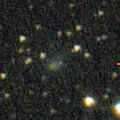
|
It brightened rapidly in outburst up to 6.9 mag (July 19, Maik Meyer). It is fading after that. Now it is 9.3 mag (Aug. 2, Katsumi Yoshimoto). It approaches to Sun down to 0.2 a.u. in August, and it was expected to brighten up to 3 mag. However, it must have been already disintegrated. Now it is not observable. In the Northern Hemisphere, it will appear in the morning sky in late October. But it will be too faint to observe.
Date(TT) R.A. (2000) Decl. Delta r Elong. m1 Best Time(A, h)
Aug. 25 10 28.38 3 46.3 1.354 0.380 7 6.5 20:06 (110,-20)
Sept. 1 10 57.02 7 3.1 1.565 0.564 4 8.5 19:55 (110,-15)
|
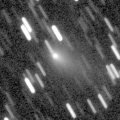
|
Now it is very bright as 7.3 mag (Aug. 19, Maik Meyer). It will brighten up to 7 mag from August to September. In the Northern Hemisphere, it will be observable in excellent condition. In the Southern Hemisphere, it will be unobservable from July to August. But it will be observable in good condition before and after that.
Date(TT) R.A. (2000) Decl. Delta r Elong. m1 Best Time(A, h)
Aug. 25 4 9.28 57 19.5 0.435 1.039 81 7.2 3:57 (212, 60)
Sept. 1 5 1.03 48 16.8 0.407 1.022 80 6.9 4:04 (231, 61)
|

|
It brightened up to 7.7 mag in June (June 19, Juan Jose Gonzalez). Now it is fading. But it is still bright as 9.0 mag (Aug. 15, Marco Goiato). It stays bright as 9-10 mag for a while. In the Southern Hemisphere, it stays observable in good condition for a long time until the comet will fade out. In the Northern Hemisphere, it is not observable for a long time until autumn in 2019 when the comet fades out down to 16 mag.
Date(TT) R.A. (2000) Decl. Delta r Elong. m1 Best Time(A, h)
Aug. 25 14 35.87 -57 46.6 2.032 2.217 86 9.2 20:06 ( 27,-14)
Sept. 1 14 29.65 -58 16.7 2.144 2.225 81 9.4 19:55 ( 29,-17)
|
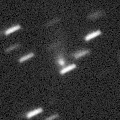
|
It brightened up to 8.7 mag in July (July 18, Marco Goiato). Now it is fading. But it is still bright as 10.2 mag (Aug. 14, Chris Wyatt). In the Southern Hemisphere, it is observable until September, but it locates in extremely low. In the Northern Hemisphere, it is not observable until late December.
Date(TT) R.A. (2000) Decl. Delta r Elong. m1 Best Time(A, h)
Aug. 25 10 52.62 -30 29.7 1.569 1.069 42 10.3 20:06 ( 73,-33)
Sept. 1 11 33.02 -30 51.6 1.696 1.151 41 10.8 19:55 ( 71,-29)
|

|
It approached to Earth down to 0.3 a.u., and brightened up to 8.3 mag in July (July 22, Juan Jose Gonzalez). Now it is fading. But it is still bright as 10.4 mag (Aug. 14, Chris Wyatt). It will go away from Earth after this, and will fade out rapidly. It stays observable in good condition until September. It locates somewhat low in the Northern Hemisphere.
Date(TT) R.A. (2000) Decl. Delta r Elong. m1 Best Time(A, h)
Aug. 25 15 18.93 -11 31.1 1.112 1.352 78 11.5 20:06 ( 51, 27)
Sept. 1 15 12.20 -9 59.2 1.344 1.382 70 12.0 19:55 ( 57, 24)
|
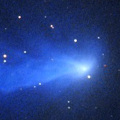
|
Now it is 10.4 mag (Aug. 14, Juan Jose Gonzalez). It will be fading slowly after this. In the Northern Hemisphere, it stays low until October. But it will be observable in good condition after that. In the Southern Hemisphere, it is not observable until summer in 2019.
Date(TT) R.A. (2000) Decl. Delta r Elong. m1 Best Time(A, h)
Aug. 25 10 37.06 51 21.4 3.528 2.839 40 11.7 20:06 (144, 13)
Sept. 1 10 58.42 50 43.5 3.532 2.869 42 11.7 19:55 (143, 13)
|

|
Now it is 12.9 mag (Aug. 18, Paul Camilleri). It will brighten rapidly after this, and it is expected to brighten up to 9 mag from autumn to winter. In the Northern Hemisphere, it stays observable in good condition for a long time until it fades out. In the Southern Hemispehre, it is observable in good condition until autumn, but it will be low in winter.
Date(TT) R.A. (2000) Decl. Delta r Elong. m1 Best Time(A, h)
Aug. 25 4 26.85 6 17.1 1.641 1.861 85 12.3 3:57 (304, 47)
Sept. 1 4 43.23 7 17.0 1.548 1.819 88 11.9 4:04 (308, 51)
|

|
Now it is 11.7 mag (June 12, Juan Jose Gonzalez). It will appear in the morning sky soon in the Northern Hemisphere, or in late September in the Southern Hemisphere. It stays 12 mag for a long time until spring.
Date(TT) R.A. (2000) Decl. Delta r Elong. m1 Best Time(A, h)
Aug. 25 8 49.00 21 41.5 3.600 2.698 23 12.3 3:57 (247, 4)
Sept. 1 8 52.25 19 53.3 3.556 2.710 28 12.3 4:04 (252, 9)
|
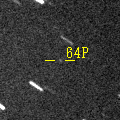
|
It brightened in outburst on Aug. 14. Now it is bright as 13.0 mag (Aug. 15, Chris Wyatt). It will be observable in excellent condition in the Northern Hemisphere. It stays low in the Southern Hemisphere.
Date(TT) R.A. (2000) Decl. Delta r Elong. m1 Best Time(A, h)
Aug. 25 0 13.23 17 46.6 0.723 1.626 138 13.0 2:02 ( 0, 73)
Sept. 1 0 17.55 20 27.1 0.663 1.587 142 12.6 1:39 ( 0, 75)
|
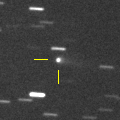
|
Now it is bright as 12.6 mag (Aug. 18, Chris Wyatt). It stays at 12-13 mag from summer to autumn. It is observable in excellent condition in the Southern Hemisphere. It locates somewhat low in the Northern Hemisphere.
Date(TT) R.A. (2000) Decl. Delta r Elong. m1 Best Time(A, h)
Aug. 25 22 38.17 -26 5.6 1.016 2.007 163 12.6 0:27 ( 0, 29)
Sept. 1 22 35.17 -27 10.6 1.029 2.011 161 12.7 23:53 ( 0, 28)
|

|
Now it is 14.1 mag (Aug. 18, Chris Wyatt).
Date(TT) R.A. (2000) Decl. Delta r Elong. m1 Best Time(A, h)
Aug. 25 23 8.50 1 13.9 4.805 5.774 161 13.1 0:58 ( 0, 56)
Sept. 1 23 5.43 1 1.9 4.781 5.774 168 13.1 0:27 ( 0, 56)
|
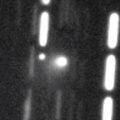
|
Now it is 13.9 mag (Aug. 11, Paul Camilleri). It stays at 14-15 mag for a long time from summer to winter. In the Southern Hemisphere, it will be getting lower rapidly after this, then it becomes unobservable after October. In the Northern Hemisphere, it stays observable for a long time until it fades out. But it stays extremely low.
Date(TT) R.A. (2000) Decl. Delta r Elong. m1 Best Time(A, h)
Aug. 25 14 27.68 -11 43.8 2.319 2.136 66 14.1 20:06 ( 61, 18)
Sept. 1 14 36.64 -10 7.4 2.362 2.085 61 14.1 19:55 ( 63, 18)
|
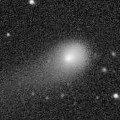
|
Now it is 12.8 mag (July 13, Seiichi Yoshida). It will be observable at 12-13 mag for a long time from 2017 to 2018. In the Southern Hemisphere, it will be hardly observable after this. It becomes extremely low in September also in the Northern Hemisphere.
Date(TT) R.A. (2000) Decl. Delta r Elong. m1 Best Time(A, h)
Aug. 25 11 46.34 38 42.4 4.871 4.079 34 14.2 20:06 (127, 15)
Sept. 1 11 47.84 37 52.9 4.911 4.104 33 14.2 19:55 (128, 12)
|
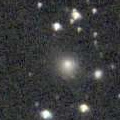
|
Now it is 14.1 mag (Aug. 11, Paul Camilleri). It stays 13-14 mag until summer in 2019. In the Northern Hemisphere, it stays observable in good condition for a while. It locates somewhat low in the Southern Hemisphere.
Date(TT) R.A. (2000) Decl. Delta r Elong. m1 Best Time(A, h)
Aug. 25 16 22.93 23 59.6 3.431 3.535 87 14.2 20:06 ( 74, 62)
Sept. 1 16 20.20 21 16.9 3.497 3.510 82 14.2 19:55 ( 74, 57)
|

|
Now it is 17.6 mag (Aug. 5, Toshihiko Ikemura, Hirohisa Sato). It will approach to Earth down to 0.08 a.u. in December, and it is expected to brighten up to 3 mag. In the Northern Hemisphere, it stays observable in excellent condition. In the Southern Hemisphere, it is observable in good condition until mid December when it brightens up to 3 mag. But it becomes unobservable after that.
Date(TT) R.A. (2000) Decl. Delta r Elong. m1 Best Time(A, h)
Aug. 25 1 24.97 -16 52.0 0.870 1.728 133 14.8 3:13 ( 0, 38)
Sept. 1 1 32.19 -18 12.5 0.781 1.668 137 14.2 2:53 ( 0, 37)
|
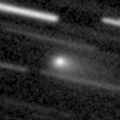
|
Now it is bright as 13.7 mag (Aug. 15, Chris Wyatt). It stays observable in good condition for a long time after this. But it will be fading gradually.
Date(TT) R.A. (2000) Decl. Delta r Elong. m1 Best Time(A, h)
Aug. 25 23 31.38 6 19.4 0.979 1.940 154 14.3 1:21 ( 0, 61)
Sept. 1 23 24.91 6 30.0 0.993 1.975 161 14.6 0:47 ( 0, 62)
|
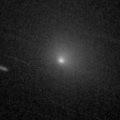
|
It brightened rapidly, and brightened up to 10.2 mag from May to June (May 22, Chris Wyatt). Now it is fading. It has already faded down to 13.8 mag (Aug. 15, Chris Wyatt). It stays observable in good condition for a long time after this. But it will be fainter than 18 mag in October.
Date(TT) R.A. (2000) Decl. Delta r Elong. m1 Best Time(A, h)
Aug. 25 1 12.25 -14 7.2 0.929 1.802 136 14.5 3:01 ( 0, 41)
Sept. 1 1 3.47 -13 28.3 0.945 1.861 144 15.0 2:25 ( 0, 42)
|
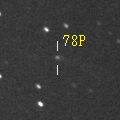
|
Now it is 14.9 mag (Aug. 8, Toshihiko Ikemura, Hirohisa Sato). It stays at 13 mag for a long time from winter to autumn in 2019. It stays observable in good condition until winter when the comet brightens up to 13 mag.
Date(TT) R.A. (2000) Decl. Delta r Elong. m1 Best Time(A, h)
Aug. 25 21 38.41 -4 36.4 1.642 2.641 169 14.7 23:23 ( 0, 50)
Sept. 1 21 33.22 -5 13.9 1.628 2.610 163 14.6 22:51 ( 0, 50)
|
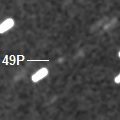
|
The condition is worst in this apparition. It brightens up to 14.5 mag from June to August, but it is not observable at all.
Date(TT) R.A. (2000) Decl. Delta r Elong. m1 Best Time(A, h)
Aug. 25 9 1.27 17 16.2 2.420 1.498 18 14.9 3:57 (249, 0)
Sept. 1 9 22.98 16 38.7 2.428 1.523 20 15.1 4:04 (251, 2)
|

|
Now it is 15.1 mag (June 18, Martin Masek). It stays 15 mag from 2018 to 2019, and it will be observable for a long time in the Southern Hemisphere. In the Northern Hemisphere, it will never be observable again.
Date(TT) R.A. (2000) Decl. Delta r Elong. m1 Best Time(A, h)
Aug. 25 12 58.94 -64 31.7 4.189 4.163 81 15.0 20:06 ( 28,-27)
Sept. 1 13 11.94 -64 50.2 4.223 4.143 78 15.0 19:55 ( 28,-28)
|

|
Now it is 16.3 mag (Jan. 11, ATLAS-HKO, Haleakala). It will brighten up to 14 mag in winter. It will be observable in excellent condition in the Northern Hemisphere. It will be unobservable soon in the Southern Hemisphere.
Date(TT) R.A. (2000) Decl. Delta r Elong. m1 Best Time(A, h)
Aug. 25 4 37.63 41 32.5 1.992 2.045 78 15.1 3:57 (246, 60)
Sept. 1 4 53.69 44 37.6 1.909 2.025 81 15.0 4:04 (239, 63)
|

|
Now it is 16.9 mag (Aug. 18, Toshihiko Ikemura, Hirohisa Sato). It is observable at 15-16 mag in 2018, in good condition in the Southern Hemisphere. It locates somewhat low in the Northern Hemisphere.
Date(TT) R.A. (2000) Decl. Delta r Elong. m1 Best Time(A, h)
Aug. 25 23 18.30 -18 41.3 2.297 3.276 162 15.3 1:07 ( 0, 36)
Sept. 1 23 13.57 -19 10.7 2.300 3.290 166 15.3 0:35 ( 0, 36)
|
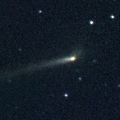
|
It brightened rapidly as predicted, and brightened up to 11.1 mag (July 13, Chris Wyatt). Now it is fading. But it is still bright as 13.6 mag (Aug. 18, Chris Wyatt). In the Southern Hemisphere, it stays observable in good condition all through this apparition. It becomes observable also in the Northern Hemisphere, but it stays low.
Date(TT) R.A. (2000) Decl. Delta r Elong. m1 Best Time(A, h)
Aug. 25 2 5.56 -33 54.5 0.350 1.236 122 15.6 3:55 ( 0, 21)
Sept. 1 1 32.23 -32 24.0 0.391 1.309 133 16.5 2:54 ( 0, 23)
|
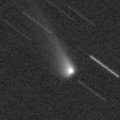
|
Now it is 16.8 mag (Aug. 5, Toshihiko Ikemura, Hirohisa Sato). Fading now. It stays observable in good condition for a long time after this in the Southern Hemisphere. It stays low in the Northern Hemisphere.
Date(TT) R.A. (2000) Decl. Delta r Elong. m1 Best Time(A, h)
Aug. 25 0 22.79 -28 40.5 3.876 4.740 145 15.7 2:12 ( 0, 27)
Sept. 1 0 13.85 -30 36.0 3.873 4.765 148 15.7 1:35 ( 0, 25)
|

|
It brightened up to 7.1 mag from May to June in 2017 (June 21, Juan Jose Gonzalez). Now it is fading. It has already faded down to 15.0 mag (July 15, Thomas Lehmann). In the Southern Hemisphere, it stays observable for a long time after this. It will never be observable again in the Northern Hemisphere.
Date(TT) R.A. (2000) Decl. Delta r Elong. m1 Best Time(A, h)
Aug. 25 2 4.59 -52 4.1 4.652 5.207 118 15.8 3:53 ( 0, 3)
Sept. 1 2 0.92 -52 49.9 4.692 5.269 119 15.9 3:22 ( 0, 2)
|

|
Now it is 15.9 mag (July 14, iTelescope Observatory, Siding Spring). It will brighten up to 12 mag in autumn in 2019. It stays observable in good condition for a while in the Southern Hemisphere. In the Northern Hemisphere, it stays extremely low for a long time.
Date(TT) R.A. (2000) Decl. Delta r Elong. m1 Best Time(A, h)
Aug. 25 3 11.07 -44 6.8 4.722 5.138 108 16.0 3:57 (349, 10)
Sept. 1 3 8.04 -44 45.0 4.624 5.091 112 15.9 4:04 (356, 10)
|
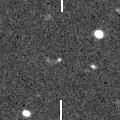
|
Now it is 17.0 mag (July 15, Toshihiko Ikemura, Hirohisa Sato). It brightens up to 16 mag from August to October. But it stays low.
Date(TT) R.A. (2000) Decl. Delta r Elong. m1 Best Time(A, h)
Aug. 25 13 45.71 -2 16.5 1.871 1.520 54 16.2 20:06 ( 75, 16)
Sept. 1 14 5.40 -4 13.5 1.900 1.521 52 16.1 19:55 ( 73, 16)
|
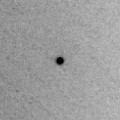
|
Now it is 16.2 mag (June 17, Jean-Francois Soulier). It stays 16 mag for a while. In the Northern Hemisphere, it stays observable in good condition after this until it fades out. It will be unobservable soon in the Southern Hemisphere. Its cometary activity was observed on Mar. 26 (M. Mommert, D. Polishook, N. Moskovitz).
Date(TT) R.A. (2000) Decl. Delta r Elong. m1 Best Time(A, h)
Aug. 25 3 1.25 39 41.0 1.410 1.827 96 16.4 3:57 (242, 79)
Sept. 1 3 1.91 42 32.5 1.400 1.884 101 16.5 4:04 (205, 82)
|
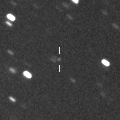
|
Now it is 16.0 mag (Aug. 12, Gabor Santa). It will be observable at 16.5 mag in good condition from August to September.
Date(TT) R.A. (2000) Decl. Delta r Elong. m1 Best Time(A, h)
Aug. 25 21 32.24 -5 9.0 1.181 2.181 168 16.5 23:17 ( 0, 50)
Sept. 1 21 28.14 -5 33.8 1.170 2.152 162 16.6 22:46 ( 0, 49)
|

|
Now it is around the apheilon. But it brightened up to 15.8 mag in outburst (July 21, Hidetaka Sato). Now it is getting diffused. But it is bright as 16.2 mag still now (Aug. 18, Toshihiko Ikemura, Hirohisa Sato).
Date(TT) R.A. (2000) Decl. Delta r Elong. m1 Best Time(A, h)
Aug. 25 21 4.25 -13 25.7 3.662 4.637 162 16.5 22:49 ( 0, 42)
Sept. 1 21 0.80 -13 44.9 3.701 4.636 155 16.7 22:18 ( 0, 41)
|
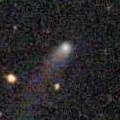
|
It brightened up to 14.7 mag in early 2018 (Jan. 25, Catalina Sky Survey). Now it is fading slowly. In the Northern Hemisphere, it stays observable in good condition for a long time until the comet fades out. It is never observable again in the Southern Hemisphere.
Date(TT) R.A. (2000) Decl. Delta r Elong. m1 Best Time(A, h)
Aug. 25 8 5.83 50 44.4 6.335 5.704 47 16.6 3:57 (225, 27)
Sept. 1 8 9.84 51 30.4 6.275 5.722 52 16.6 4:04 (226, 31)
|
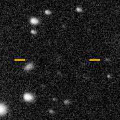
|
It will be observable at 16 mag in good condition from autumn to winter. It locates somewhat low in the Southern Hemisphere.
Date(TT) R.A. (2000) Decl. Delta r Elong. m1 Best Time(A, h)
Aug. 25 6 20.99 30 16.4 2.755 2.365 57 16.7 3:57 (256, 38)
Sept. 1 6 35.53 30 7.1 2.684 2.362 60 16.6 4:04 (259, 41)
|
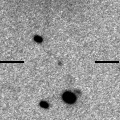
|
Now it is 16.8 mag (Aug. 8, Toshihiko Ikemura, Hirohisa Sato). It is expected to brighten up to 7-8 mag in 2020. In 2018, it will be observable at 15-16 mag in good condition from autum to winter.
Date(TT) R.A. (2000) Decl. Delta r Elong. m1 Best Time(A, h)
Aug. 25 4 2.06 -3 57.1 6.602 6.743 93 16.9 3:57 (320, 43)
Sept. 1 4 2.52 -4 7.3 6.440 6.686 99 16.8 4:04 (330, 47)
|

|
It will brighten up to 13-14 mag in winter, and it will be observable in excellent condition.
Date(TT) R.A. (2000) Decl. Delta r Elong. m1 Best Time(A, h)
Aug. 25 7 25.48 30 53.0 3.099 2.470 43 17.0 3:57 (249, 25)
Sept. 1 7 40.69 30 48.7 3.015 2.445 47 16.9 4:04 (251, 29)
|

|
Now it is 16.0 mag (Apr. 6, Sandor Szabo). It stays 16-17 mag for a long time until 2020. It is observable in good conditioin in the Northern Hemisphere. It is not observable at all in the Southern Hemisphere.
Date(TT) R.A. (2000) Decl. Delta r Elong. m1 Best Time(A, h)
Aug. 25 9 35.69 67 41.0 9.023 8.517 57 16.9 3:57 (203, 24)
Sept. 1 9 46.73 67 33.3 8.975 8.511 59 16.9 4:04 (204, 26)
|
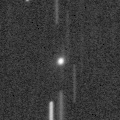
|
It brightened rapidly. Now it is 16.1 mag (Aug. 5, Toshihiko Ikemura, Hirohisa Sato). It will be fading after this, and will be fainter than 18 mag in September.
Date(TT) R.A. (2000) Decl. Delta r Elong. m1 Best Time(A, h)
Aug. 25 15 48.55 -15 52.0 2.016 2.207 86 16.9 20:06 ( 41, 28)
Sept. 1 15 59.44 -18 14.8 2.129 2.246 83 17.2 19:55 ( 41, 25)
|

|
Now it is 17.3 mag (Feb. 20, Toshihiko Ikemura, Hirohisa Sato). It stays 17 mag in 2018.
Date(TT) R.A. (2000) Decl. Delta r Elong. m1 Best Time(A, h)
Aug. 25 5 7.63 4 53.2 7.657 7.476 75 17.2 3:57 (296, 39)
Sept. 1 5 9.73 4 38.7 7.585 7.510 81 17.2 4:04 (303, 45)
|

|
Now it is 16.9 mag (Aug. 19, Toshihiko Ikemura, Hirohisa Sato). It will be fading gradually after this, and it will be fainter than 18 mag in winter. In the Northern Hemisphere, it stays observable in good condition for a long time. In the Southern Hemisphere, it will never be observable again.
Date(TT) R.A. (2000) Decl. Delta r Elong. m1 Best Time(A, h)
Aug. 25 23 27.84 77 50.2 7.451 7.530 90 17.2 1:17 (180, 47)
Sept. 1 23 20.19 77 52.8 7.427 7.556 93 17.2 0:42 (180, 47)
|
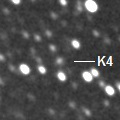
|
Now it is 17.8 mag (Aug. 8, Toshihiko Ikemura, Hirohisa Sato). It was observed at 16 mag from summer to autumn in 2017. It will be observable at 17 mag in good condition also in 2018. It locates somewhat low in the Southern Hemisphere.
Date(TT) R.A. (2000) Decl. Delta r Elong. m1 Best Time(A, h)
Aug. 25 1 11.24 29 4.1 2.830 3.467 121 17.2 3:00 ( 0, 84)
Sept. 1 1 9.50 29 33.0 2.801 3.509 127 17.3 2:31 ( 0, 85)
|

|
First return of a new periodic comet which brightened up to 16.5 mag in 2005. Now it is 19.1 mag (June 14, E. Schwab, D. Abreu). It will be observable at 17 mag in good condition in autumn. It locates low in the Southern Hemisphere.
Date(TT) R.A. (2000) Decl. Delta r Elong. m1 Best Time(A, h)
Aug. 25 1 41.79 33 7.8 1.451 2.077 113 17.5 3:30 ( 0, 88)
Sept. 1 1 47.87 34 6.8 1.392 2.072 118 17.4 3:09 ( 0, 89)
|

|
Now it is 17.4 mag (Aug. 9, Ken-ichi Kadota). It is not observable after this in the Southern Hemisphere. It is observable in good condition in the Northern Hemisphere. But it will be fainter than 18 mag in September.
Date(TT) R.A. (2000) Decl. Delta r Elong. m1 Best Time(A, h)
Aug. 25 4 37.15 55 45.2 1.294 1.463 77 17.7 3:57 (219, 57)
Sept. 1 5 3.72 59 7.9 1.319 1.510 79 17.9 4:04 (213, 57)
|

|
First return of a new periodic comet which brightened up to 17.5 mag in 2010. Now it is 19.0 mag (Aug. 10, Erwin Schwab). It is expected to brighten up to 16.5 mag from November to December. It is observable in excellent condition in the Northern Hemisphere. It locates low in the Southern Hemisphere.
Date(TT) R.A. (2000) Decl. Delta r Elong. m1 Best Time(A, h)
Aug. 25 4 26.82 19 54.4 1.861 2.012 83 17.9 3:57 (287, 56)
Sept. 1 4 40.38 20 54.7 1.782 1.998 86 17.8 4:04 (291, 61)
|

|
First return of a new periodic comet which brightened up to 17 mag in 2008. It was predicted to brighten up to 18 mag in autumn. But actually, it is much fainter than predicted, fainter than 21.5 mag (June 22, Erwin Schwab).
Date(TT) R.A. (2000) Decl. Delta r Elong. m1 Best Time(A, h)
Aug. 25 23 13.93 -0 27.0 2.847 3.820 161 17.8 1:03 ( 0, 55)
Sept. 1 23 9.78 -0 37.6 2.823 3.819 169 17.8 0:31 ( 0, 54)
|
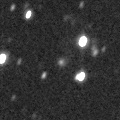
|
Now it is 17.7 mag (Aug. 8, Toshihiko Ikemura, Hirohisa Sato). It is expected to be observable at 5-6 mag for a long time from 2022 to 2023. It will be observable in good condition for a long time in the Southern Hemisphere. In the Northern Hemisphere, it is not observable at the highlight from 2022 summer to 2023 summer.
Date(TT) R.A. (2000) Decl. Delta r Elong. m1 Best Time(A, h)
Aug. 25 17 9.28 58 48.2 13.355 13.352 87 17.9 20:06 (159, 64)
Sept. 1 17 8.42 58 14.5 13.331 13.308 86 17.9 19:55 (154, 63)
|

|
It has not been recovered yet. It will brighten up to 17.5 mag from September to November.
Date(TT) R.A. (2000) Decl. Delta r Elong. m1 Best Time(A, h)
Aug. 25 2 5.15 -12 55.9 1.489 2.215 123 18.0 3:53 ( 0, 42)
Sept. 1 2 7.82 -13 7.4 1.430 2.207 128 17.9 3:29 ( 0, 42)
|
|
![]()
 C/2016 R2 ( PanSTARRS )
C/2016 R2 ( PanSTARRS ) 38P/Stephan-Oterma
38P/Stephan-Oterma C/2016 N6 ( PanSTARRS )
C/2016 N6 ( PanSTARRS ) 64P/Swift-Gehrels
64P/Swift-Gehrels 48P/Johnson
48P/Johnson 29P/Schwassmann-Wachmann 1
29P/Schwassmann-Wachmann 1 C/2018 L2 ( ATLAS )
C/2018 L2 ( ATLAS ) C/2015 O1 ( PanSTARRS )
C/2015 O1 ( PanSTARRS ) C/2017 M4 ( ATLAS )
C/2017 M4 ( ATLAS ) 46P/Wirtanen
46P/Wirtanen 37P/Forbes
37P/Forbes 66P/du Toit
66P/du Toit 78P/Gehrels 2
78P/Gehrels 2 49P/Arend-Rigaux
49P/Arend-Rigaux C/2017 B3 ( LINEAR )
C/2017 B3 ( LINEAR ) (944) Hidalgo
(944) Hidalgo 65P/Gunn
65P/Gunn 364P/2018 A2 ( PanSTARRS )
364P/2018 A2 ( PanSTARRS ) C/2015 V1 ( PanSTARRS )
C/2015 V1 ( PanSTARRS ) C/2015 V2 ( Johnson )
C/2015 V2 ( Johnson ) C/2018 N2 ( ASASSN )
C/2018 N2 ( ASASSN ) 125P/Spacewatch
125P/Spacewatch (3552) Don Quixote
(3552) Don Quixote 137P/Shoemaker-Levy 2
137P/Shoemaker-Levy 2 129P/Shoemaker-Levy 3
129P/Shoemaker-Levy 3 C/2016 A1 ( PanSTARRS )
C/2016 A1 ( PanSTARRS ) 59P/Kearns-Kwee
59P/Kearns-Kwee C/2017 T2 ( PanSTARRS )
C/2017 T2 ( PanSTARRS ) 123P/West-Hartley
123P/West-Hartley C/2010 U3 ( Boattini )
C/2010 U3 ( Boattini ) C/2018 C2 ( Lemmon )
C/2018 C2 ( Lemmon ) C/2011 KP36 ( Spacewatch )
C/2011 KP36 ( Spacewatch ) C/2014 OE4 ( PanSTARRS )
C/2014 OE4 ( PanSTARRS ) C/2017 K4 ( ATLAS )
C/2017 K4 ( ATLAS ) P/2018 L3 ( NEAT )
P/2018 L3 ( NEAT ) C/2018 M1 ( Catalina )
C/2018 M1 ( Catalina ) P/2018 P1 ( Hill )
P/2018 P1 ( Hill ) P/2008 O2 ( McNaught )
P/2008 O2 ( McNaught ) C/2017 K2 ( PanSTARRS )
C/2017 K2 ( PanSTARRS ) P/2001 R6 ( LINEAR-Skiff )
P/2001 R6 ( LINEAR-Skiff )![]()
































